Counter-rotating cores in Jupiter's circum-polar cyclones observed by JunoCam and modeled in 2D
- 1Stuttgart, Germany (gerald.eichstaedt@t-online.de)
- 2Michigan Technological University, Houghton, MI, USA
- 3University of Michigan, Ann Arbor, MI, USA
- 4British Astronomical Association, London, UK
- 5Jet Propulsion Laboratory, California Institute of Technology, Pasadena, USA
- 6Planetary Science Institute, Tucson, AZ, USA
- 7Southwest Research Institute, San Antonio, Texas, USA
Introduction
Storms on Earth barely develop counter-rotating cores nor do so computer simulations of two-dimensional and incompressible Euler fluids [2]. But on Jupiter, JunoCam [1], the visible light imager on NASA's Juno spacecraft, collected image data of northern circumpolar cyclones (CPCs) that show distinct counter-rotating cores. Those cores occur either frequently, or they are often stable over several months.
The data points of our long-term time series are separated by the duration of at least one Juno orbit. Short-term image sequences taken during each of the considered Jupiter flybys reveal the morphology as well as the dynamics of a CPC.
While color images provide sufficient detail to measure angular velocities by stereo correspondence, and to derive vorticity maps, some of the methane-band image sequences reveal that counter-rotating cores do not stand out significantly. Two layers of clouds, one with a converging cyclonic flow, and one with a diverging anticyclonic flow, are not immediatley suggested by methane-band images. Therefore, a fluid-dynamical solution of counter-rotation within a two dimensional geometry ought to be found.
A counter-rotating core in a vortex of a two-dimensional Euler fluid is unstable. It is either ejected or disrupted in many cases.
Modelling a second layer, one with a steady flow, and allowing for some friction with the two-dimensional fluid of interest, can stabilize the counter-rotating core. The friction acts equivalently to vortex flux into or out of the layer of interest. The vortex flux is defined to be proportional to the difference between the vorticity fields of the two fluid layers, while the reference vorticity field remains constant. The global parameter of proportionality can be varied between 0 and 1, where 0 means no effect to the two-dimensional Euler fluid, and 1 means an identical copy of the steady flow. It's convenient to define the parameter of proportionality in terms the half-life of the vorticity flux in a sense that after that time, half of the vorticity difference would be leveled out in the absence of dynamics. A half-life of infinity translates into a parameter of proportionality of 0 for each simulation step, and a half-life of 0 translates into a parameter of proportionality of 1.
Vorticity maps and radial vorticity profiles in JunoCam images of CPCs
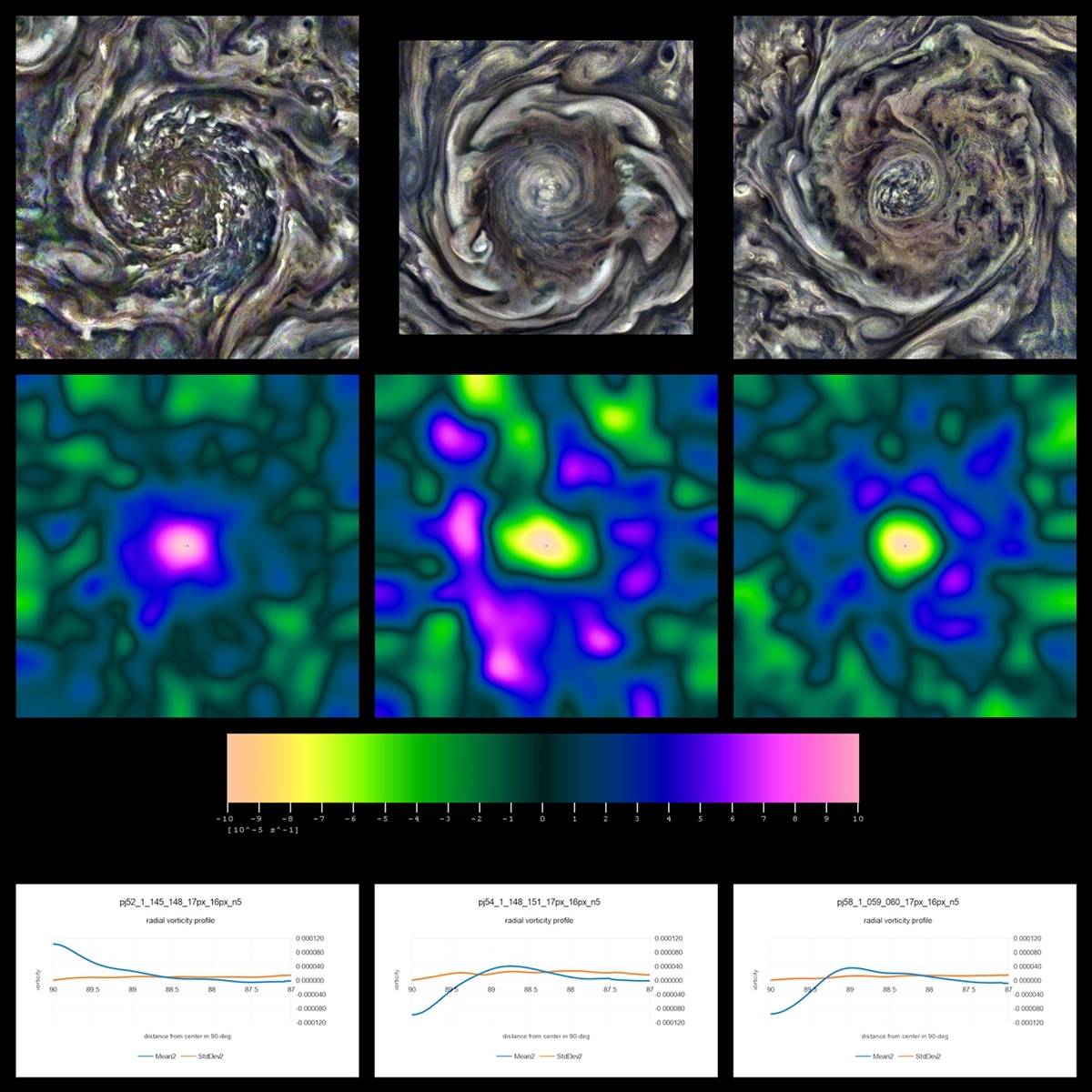
Figure 1
The first column of Figure 1 shows a northern CPC without a counter-rotating core. The angular velocity is increasing with decreasing distance from its center. The morphology shows a typical spiral structure, the vorticity map shows a strongly cyclonic core, and the radial vorticity profile (blue line in the diagram) has its cyclonic maximum at the center of the cyclone (left end of the x-axis).
The two other columns show two CPCs with counter-rotating cores. The central column shows a gradual transition from cyclonic to anticyclonic rotation with decreasing radius, while the right colums shows a sharp boundary between the anticyclonic core and its cyclonic environment. In both cases, the radial vorticity profile shows an anticyclonic maximum at the center of the cyclone and a shallow local cyclonic maximum outside the center of the cyclone.
While an anticyclonic morphology can form for a cyclone with cyclonic vorticity decreasing towards the center, measurements of the dynamics return distinct anticyclonic rotation in the cores.
Long-term stability of anticyclonic cores
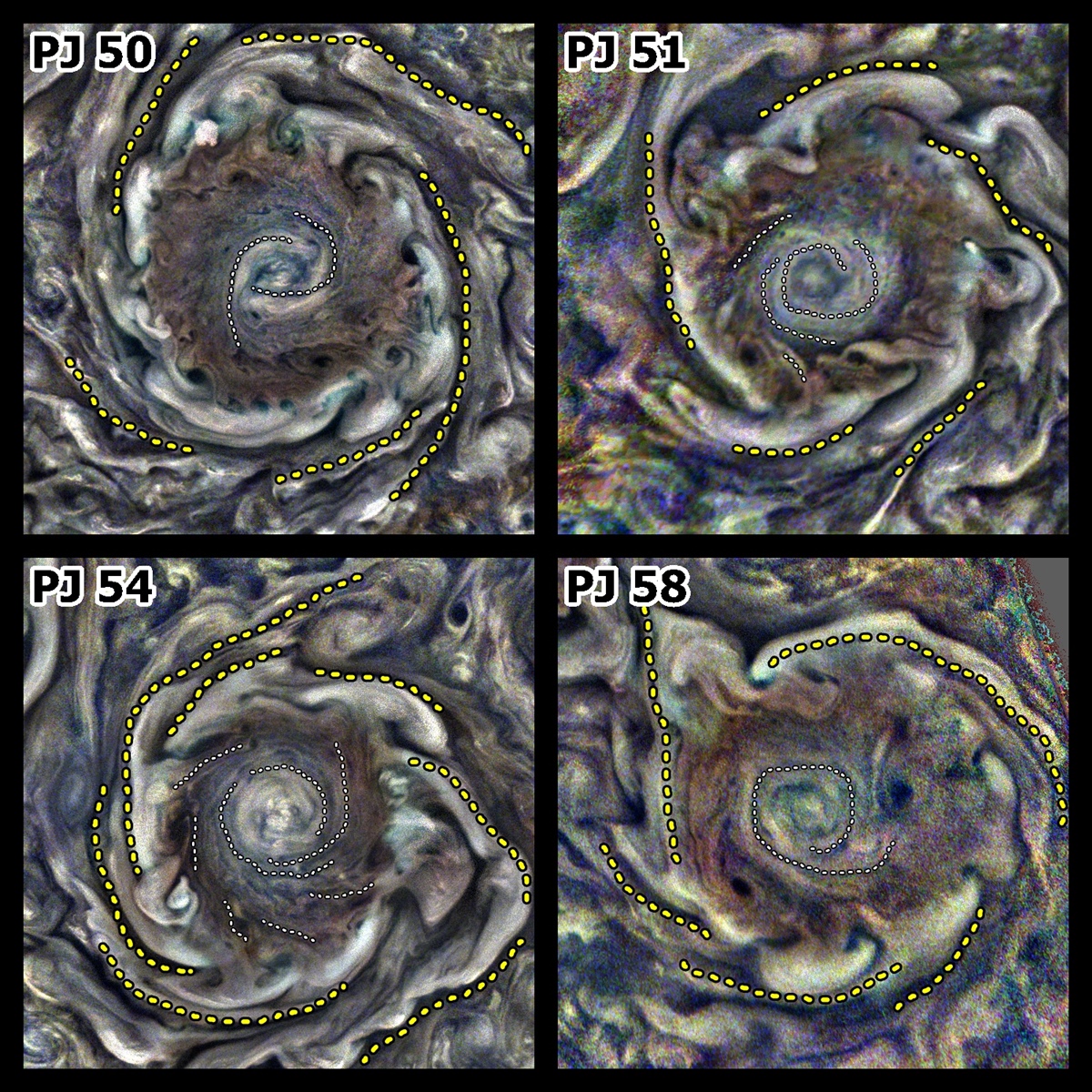
Figure 2
JunoCam observes the same CPC during several Jupiter flybys. Figure 2 shows such an example. The same CPC was observed during the PJ50, PJ51, PJ54, and PJ58 flybys. Each time, an anticyclonic morphology was detected at the core of the CPC. This means either that such a morphology developed with each flyby, or, more plausibly, lasted at least from PJ50 (2023 APR 08) to PJ58 (2024 FEB 03), hence for about ten months.
Methane-band images hint towards 2D embedding of the counter-rotation
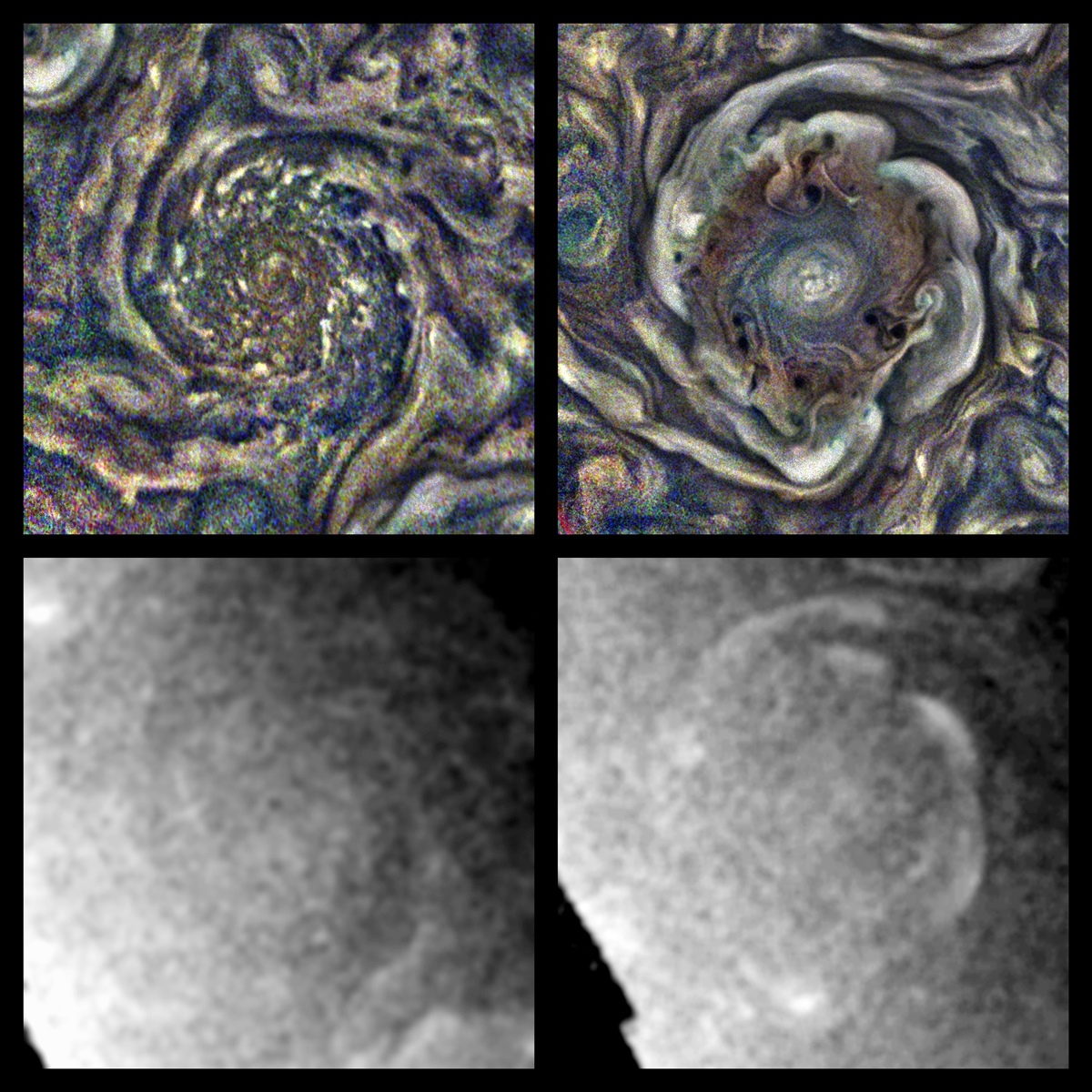
Figure 3
The left column of Figure 3 shows a CPC with a cyclonic core, while the right column shows an example with a counter-rotating core. In both cases, color and methane-band images are available. The methane-band images do not show a significant difference between the relative elevation profiles of the two cyclones. With the cyclonic core assumed to be embedded in a 2D flow, this suggests that the same should be considered for the anticyclonic core.
Counter-rotating cores are unstable in an incompressible 2D Euler flow
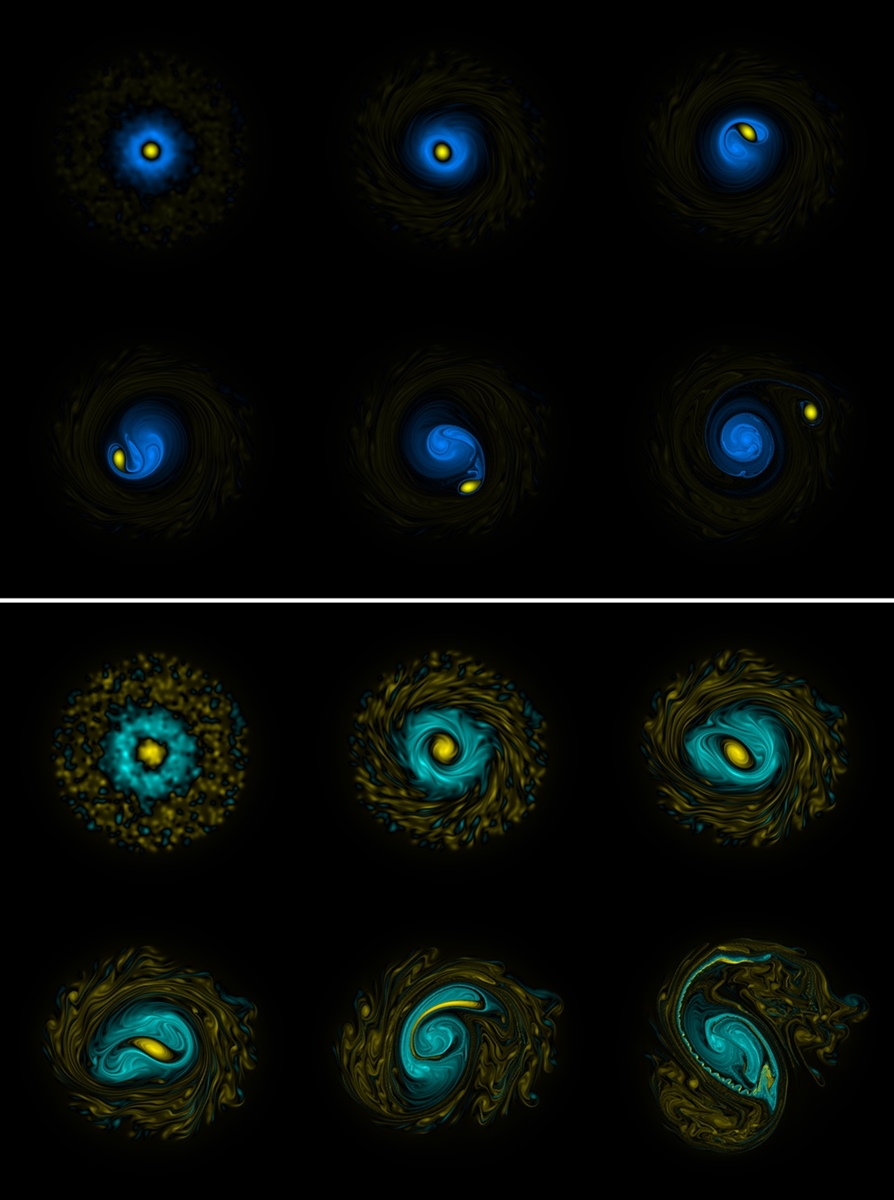
Figure 4
Counter-rotating cores in an incompressible 2D Euler flow are usually either ejected or disrupted. Figure 4 visualizes time series of both scenarios. Bluish symbolizes cyclonic vorticity, and yellowish anticyclonic vorticity.
Vorticity flux by friction with a second layer stabilizes counter-rotation
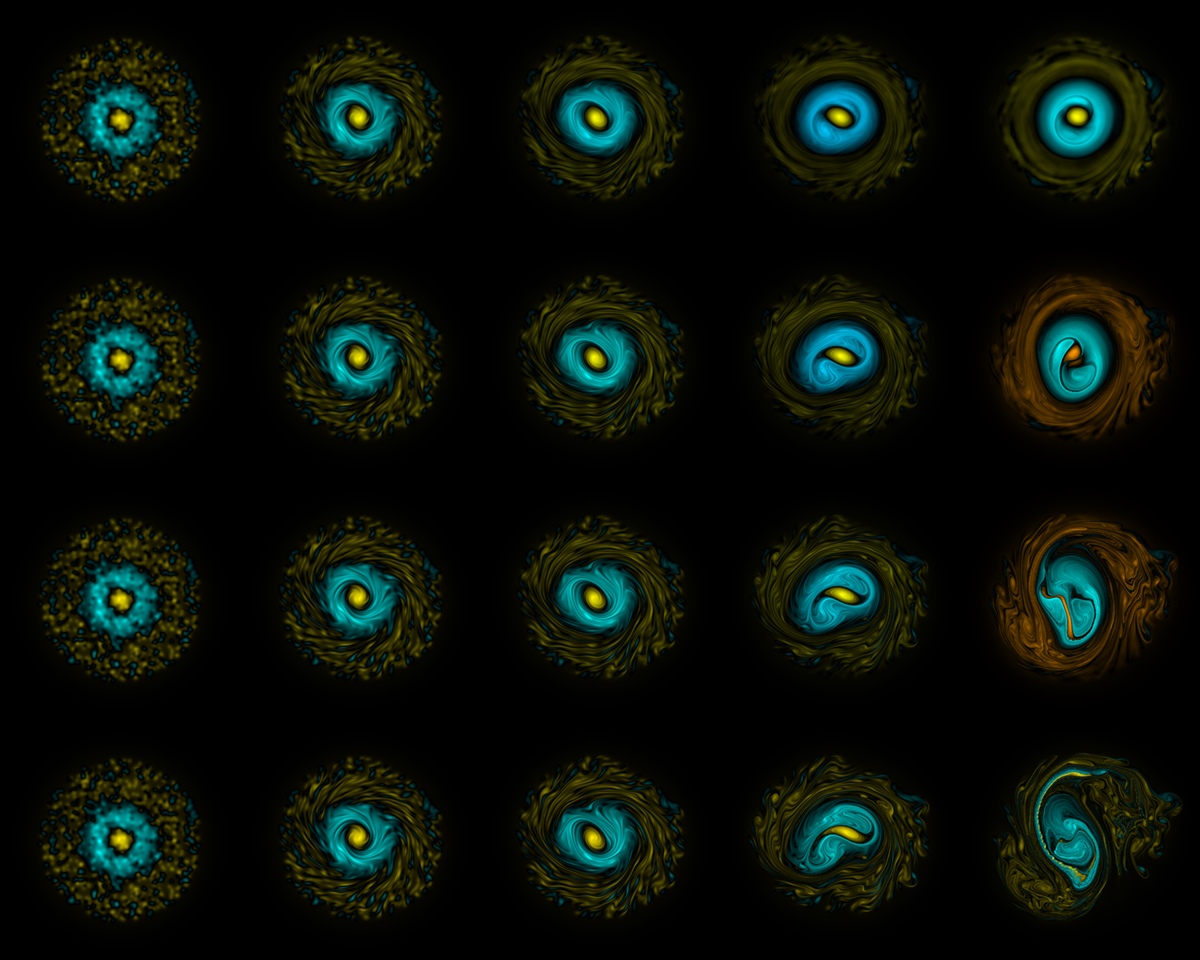
Figure 5
Each row in Figure 5 represents a time series of the same 2D flow, but with varying levels of friction with a steady flow identical to the left-most column of the survey. The half-life of the vorticity flux increases from top to bottom. The top line approximates a steady flow with a stable counter-rotating core rather quickly, while the bottom line represents just the 2D Euler fluid without friction.
Conclusion
The counter-rotating core observed in Jupiter's northern CPCs suggest to exist in an approximately 2D fluid dynamical settings. Such a flow appears to be unstable for an incompressible 2D Euler flow. But for an appropriate vorticity exchange with a steady flow in a second 2D layer, the incompressible 2D Euler flow can be extended to a vortex with a stable counter-rotating core. The cause of the assumed steady flow in the second fluid level is out of the scope of this article.
Acknowledgement
Some of this research was carried out at the Jet Propulsion Laboratory, California Institute of Technology, under a contract with the National Aeronautics and Space Administration (80NM0018D0004).
References
[1] C.J. Hansen, M.A. Caplinger, A. Ingersoll, M.A. Ravine, E. Jensen, S. Bolton, G. Orton. Junocam: Juno’s Outreach Camera. Space Sci Rev 2013:475-506, 2017
[2] Eichstädt, G., Hansen, C., and Orton, G.: Fluid Dynamical 2D Simulations of Jupiter's South Polar Region Based On JunoCam Image Data, EGU General Assembly 2020, Online, 4–8 May 2020, EGU2020-12025, https://doi.org/10.5194/egusphere-egu2020-12025, 2020.
How to cite: Eichstädt, G., Brueshaber, S., Li, C., Orton, G., Rogers, J., Hansen-Koharcheck, C., and Bolton, S.: Counter-rotating cores in Jupiter's circum-polar cyclones observed by JunoCam and modeled in 2D, Europlanet Science Congress 2024, Berlin, Germany, 8–13 Sep 2024, EPSC2024-154, https://doi.org/10.5194/epsc2024-154, 2024.